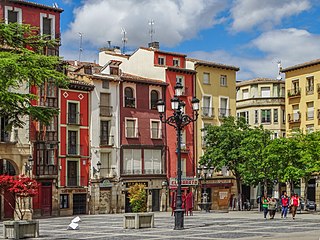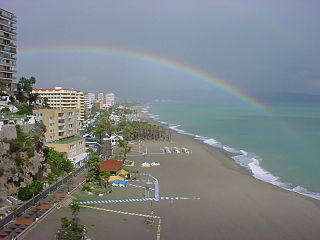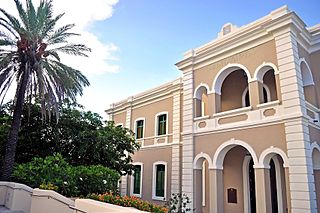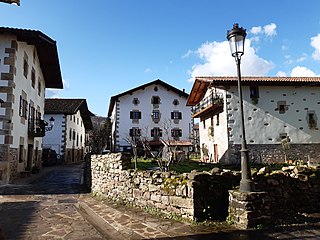
Ejea de los Caballeros, commonly known simply as Ejea, is a town and municipality in the province of Zaragoza, part of the autonomous community of Aragon, Spain. It is one of the five main towns in the Comarca de las Cinco Villas, along with Sos del Rey Católico, Uncastillo, Sádaba, and Tauste.

Logroño is the capital of the autonomous community of La Rioja, Spain. Located in the north of the Iberian Peninsula, primarily in the right (South) bank of the Ebro River, Logroño has historically been a place of passage, such as the Camino de Santiago. Its borders were disputed between the Iberian kingdoms of Castille, Navarre and Aragon during the Middle Ages.

Torremolinos is a municipality in Andalusia, southern Spain, west of Málaga. A poor fishing village before the growth in tourism began in the late 1950s, Torremolinos was the first of the Costa del Sol resorts to be developed and is still the most popular in the region.

A Coruña is a city and municipality in Galicia, Spain. It is Galicia's second largest city, behind Vigo. The city is the provincial capital of the province of A Coruña, having also served as political capital of the Kingdom of Galicia from the 16th to the 19th centuries, and as a regional administrative centre between 1833 and 1982.

The Puerto Rico Conservatory of Music is a public conservatory in San Juan, Puerto Rico. It has hosted a number of international musicians as students as well as faculty, and has a longstanding relationship with the classical music movement in Puerto Rico, including the annual Casals Festival and the Puerto Rico Symphony Orchestra (PRSO).

San Miguel de Allende is the principal city in the municipality of San Miguel de Allende, located in the far eastern part of Guanajuato, Mexico. A part of the Bajío region, the town lies 274 km (170 mi) from Mexico City, 86 km (53 mi) from Querétaro and 97 km (60 mi) from the state capital of Guanajuato. The town's name derives from a 16th-century friar, Juan de San Miguel, and a martyr of Mexican Independence, Ignacio Allende, who was born in a house facing the central plaza. San Miguel de Allende was a critical epicenter during the historic Chichimeca War (1540–1590) when the Chichimeca held back the Spanish Empire during the initial phases of European colonization. Today, an old section of the town is part of a proclaimed World Heritage Site, attracting thousands of tourists and new residents from abroad every year.
San Lorenzo is a city, with a population of 35,560, and a municipality in the Honduran department of Valle.

Chiclana de la Frontera is a town and municipality in southwestern Spain, in the province of Cádiz, Andalucía, near the Gulf of Cádiz. It belongs to the association of municipalities of the Bay of Cádiz, the provincial capital of Cádiz, Jerez de la Frontera, San Fernando, El Puerto de Santa María, Puerto Real and Rota which form the third largest metropolitan area in Andalusia, behind Seville and Málaga, and the twelfth largest in Spain. It is located 20 kilometres south-east from Cádiz, and borders the municipalities of San Fernando and Puerto Real to the north and Conil de la Frontera to the south. In 1877, the municipality's population was 11,677; in 2012, it was 81,473. It has a surface area is 203 square kilometres (78 sq mi) and a population density of 401 inhabitants / km2. The average elevation is 11 metres (36 ft) above sea level. The economy depends largely upon modern industry, especially salt processing and tourism, and the municipality is known for its beaches such as the 6 kilometres (3.7 mi) long Playa de la Barrosa, hotels and golf courses in the resort of Novo Sancti Petri. The municipality contains the largest number of hotel beds in the Province of Cádiz and the Costa de la Luz. The town's newspaper, Chiclana Información, is distributed on Saturday mornings.

Ituren is a town and municipality located in the province and autonomous community of Navarre, northern Spain. Ituren sits on a westernmost outlying area of the Pyrenees, 56.5 km north of Pamplona. It lies on the flood plain of the River Ezkurra, a tributary of the River Bidasoa, in the shadow of the Mendaur mountain which is characterised by the tiny white-washed chapel of La Trinidad, on its summit.

Oteiza or Oteiza de la Solana, is a village and a Spanish municipality of the Foral Community of Navarra, located in the merindad of Estella, in the Estella Oriental region, 51 km from the capital of the community, Pamplona. Its population in 2016 was 939.

San Adrián is a town and municipality located in the province and autonomous community of Navarre, northern Spain. There was an ancient monastery dedicated to San Adrián y la Virgen de la Palma there, after which the village is named.
San Pedro Alcántara is a town in the municipality of Marbella, in Andalucía, Spain. It is a tourist destination of the Costa del Sol.

El Cerrito is a town and municipality located in the Department of Valle del Cauca, Colombia. This is one of the 42 municipalities of the department.

San Sebastián, officially known by the bilingual name Donostia / San Sebastián, is a city and municipality located in the Basque Autonomous Community, Spain. It lies on the coast of the Bay of Biscay, 20 km from the France–Spain border. The capital city of the province of Gipuzkoa, the municipality's population is 188,102 as of 2021, with its metropolitan area reaching 436,500 in 2010. Locals call themselves donostiarra (singular), both in Spanish and Basque. It is also a part of Basque Eurocity Bayonne-San Sebastián.
Zalamea de la Serena is a municipality in the province of Badajoz, Extremadura, Spain. According to the 2014 census, the municipality has a population of 3797 inhabitants.

Vega de Tera is a municipality located in the province of Zamora, Castile and León, Spain. According to the 2004 census (INE), the municipality has a population of 470 inhabitants.

Torre-Pacheco is a municipality in the autonomous community of Murcia in southeastern Spain. It covers an area of 189.4 km2 and its population in 2019 was 35,676. The only high ground in the municipality is Cabezo Gordo hill, the location of the protected Sima de las Palomas archeological site. The town has one secondary education institution, the I.E.S. Gerardo Molina.

Usera is a district of Madrid, Spain. It lies on the southern (right) bank of the Manzanares. It is home to about 10% of the Chinese citizens who live in the Madrid region.

Plan is a municipality located in the Sobrarbe comarca, province of Huesca, Aragon, Spain. According to the 2010 census the municipality has a population of 336 inhabitants, and is the main populated center in the Gistau Valley. Its postal code is 22367.

The Lezama Facilities, are the training ground and academy of the Primera Division club Athletic Bilbao. Located in the village of Lezama, around 10–15 kilometers east of Bilbao, the facilities were opened in 1971 and currently cover 13 hectares. Athletic's academy is often referred to metonymically as Lezama.

















